By和Through的方式方法区别
- 格式:wps
- 大小:39.50 KB
- 文档页数:4
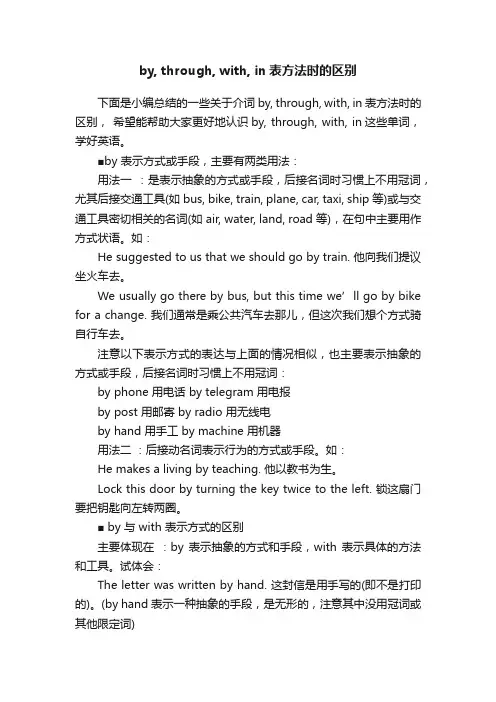
by, through, with, in表方法时的区别下面是小编总结的一些关于介词by, through, with, in表方法时的区别,希望能帮助大家更好地认识by, through, with, in这些单词,学好英语。
■by 表示方式或手段,主要有两类用法:用法一:是表示抽象的方式或手段,后接名词时习惯上不用冠词,尤其后接交通工具(如 bus, bike, train, plane, car, taxi, ship 等)或与交通工具密切相关的名词(如 air, water, land, road 等),在句中主要用作方式状语。
如:He suggested to us that we should go by train. 他向我们提议坐火车去。
We usually go there by bus, but this time we’ll go by bike for a change. 我们通常是乘公共汽车去那儿,但这次我们想个方式骑自行车去。
注意以下表示方式的表达与上面的情况相似,也主要表示抽象的方式或手段,后接名词时习惯上不用冠词:by phone 用电话 by telegram 用电报by post 用邮寄 by radio 用无线电by hand 用手工 by machine 用机器用法二:后接动名词表示行为的方式或手段。
如:He makes a living by teaching. 他以教书为生。
Lock this door by turning the key twice to the left. 锁这扇门要把钥匙向左转两圈。
■ by 与 with 表示方式的区别主要体现在:by 表示抽象的方式和手段,with 表示具体的方法和工具。
试体会:The letter was written by hand. 这封信是用手写的(即不是打印的)。
(by hand表示一种抽象的手段,是无形的,注意其中没用冠词或其他限定词)I write with my hand, but he writes with his mouth. 我用手写字,但他却用嘴写字。
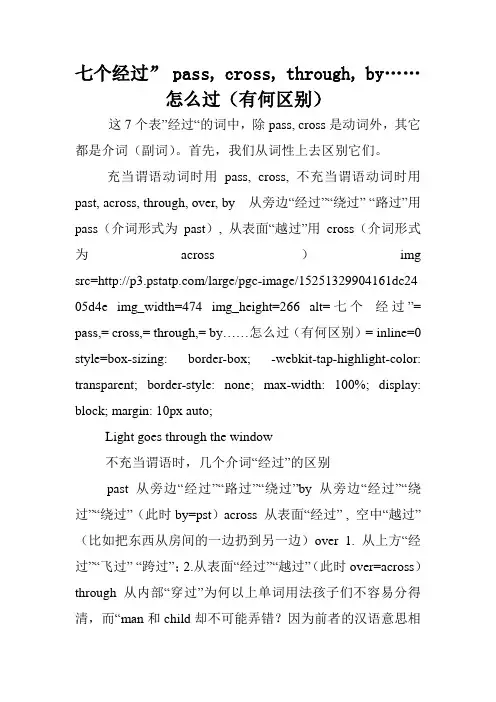
七个经过” pass, cross, through, by……怎么过(有何区别)这7个表”经过“的词中,除pass, cross是动词外,其它都是介词(副词)。
首先,我们从词性上去区别它们。
充当谓语动词时用pass, cross, 不充当谓语动词时用past, across, through, over, by从旁边“经过”“绕过” “路过”用pass (介词形式为past), 从表面“越过”用cross(介词形式为across)img src=/large/pgc-image/15251329904161dc24 05d4e img_width=474 img_height=266 alt=七个经过”= pass,= cross,= through,= by……怎么过(有何区别)= inline=0 style=box-sizing: border-box; -webkit-tap-highlight-color: transparent; border-style: none; max-width: 100%; display: block; margin: 10px auto;Light goes through the window不充当谓语时,几个介词“经过”的区别past从旁边“经过”“路过”“绕过”by从旁边“经过”“绕过”“绕过”(此时by=pst)across 从表面“经过” , 空中“越过”(比如把东西从房间的一边扔到另一边)over 1. 从上方“经过”“飞过” “跨过”;2.从表面“经过”“越过”(此时over=across)through从内部“穿过”为何以上单词用法孩子们不容易分得清,而“man和child却不可能弄错?因为前者的汉语意思相同,而后者汉语意思相距甚远。
这就给我们启示,我们尽可能将单词的用法区别在它们的汉语释义上体现出来,以便孩子们像记man和child一样只要记得意思就不会弄错。
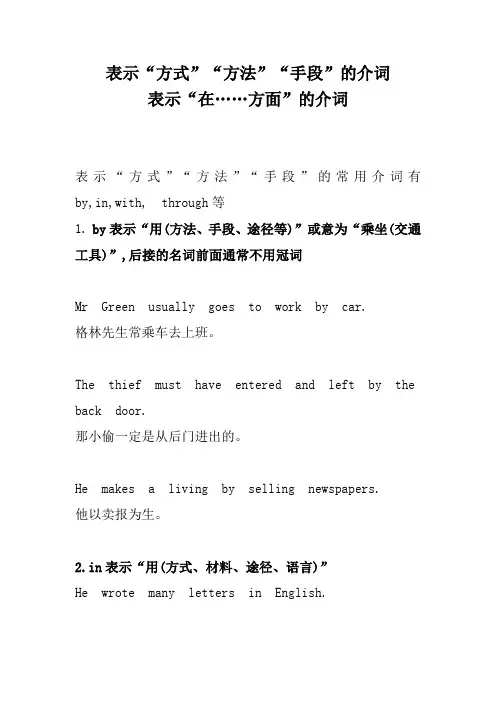
表示“方式”“方法”“手段”的介词表示“在……方面”的介词表示“方式”“方法”“手段”的常用介词有by,in,with, through等1.by表示“用(方法、手段、途径等)”或意为“乘坐(交通工具)”,后接的名词前面通常不用冠词Mr Green usually goes to work by car.格林先生常乘车去上班。
The thief must have entered and left by the back door.那小偷一定是从后门进出的。
He makes a living by selling newspapers.他以卖报为生。
2.in表示“用(方式、材料、途径、语言)”He wrote many letters in English.他用英语写了许多封信件。
You can do this in a different way.你可以以不同的方式来做这件事。
Can you sing in English?你能用英语唱歌吗?You should do it in this way.你应该这样做。
3.with表示“带着,伴随”,后接具体的工具、手段、材料或其他行为方式.He wrote these Chinese characters with a small bamboo stick.他用一根小竹棍写了这些汉字。
He plays table tennis with his left hand.他用左手打乒乓球。
He told me to write with a pen.他要我用钢笔写字。
I'm glad you're going with me.我很高兴你将和我一起去4. through表示“以(方法、手段)”“经由”.We learn a second language through listening, speaking, reading and writing.我们通过听、说、读、写来学习第二语言。
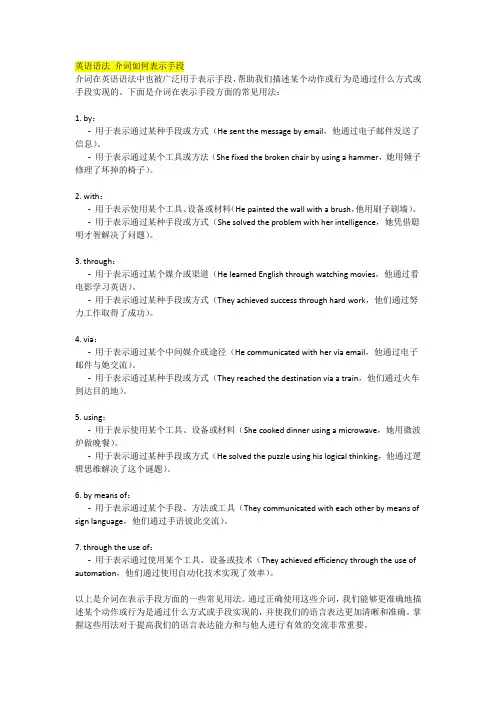
英语语法介词如何表示手段介词在英语语法中也被广泛用于表示手段,帮助我们描述某个动作或行为是通过什么方式或手段实现的。
下面是介词在表示手段方面的常见用法:1. by:-用于表示通过某种手段或方式(He sent the message by email,他通过电子邮件发送了信息)。
-用于表示通过某个工具或方法(She fixed the broken chair by using a hammer,她用锤子修理了坏掉的椅子)。
2. with:-用于表示使用某个工具、设备或材料(He painted the wall with a brush,他用刷子刷墙)。
-用于表示通过某种手段或方式(She solved the problem with her intelligence,她凭借聪明才智解决了问题)。
3. through:-用于表示通过某个媒介或渠道(He learned English through watching movies,他通过看电影学习英语)。
-用于表示通过某种手段或方式(They achieved success through hard work,他们通过努力工作取得了成功)。
4. via:-用于表示通过某个中间媒介或途径(He communicated with her via email,他通过电子邮件与她交流)。
-用于表示通过某种手段或方式(They reached the destination via a train,他们通过火车到达目的地)。
5. using:-用于表示使用某个工具、设备或材料(She cooked dinner using a microwave,她用微波炉做晚餐)。
-用于表示通过某种手段或方式(He solved the puzzle using his logical thinking,他通过逻辑思维解决了这个谜题)。
6. by means of:-用于表示通过某个手段、方法或工具(They communicated with each other by means of sign language,他们通过手语彼此交流)。

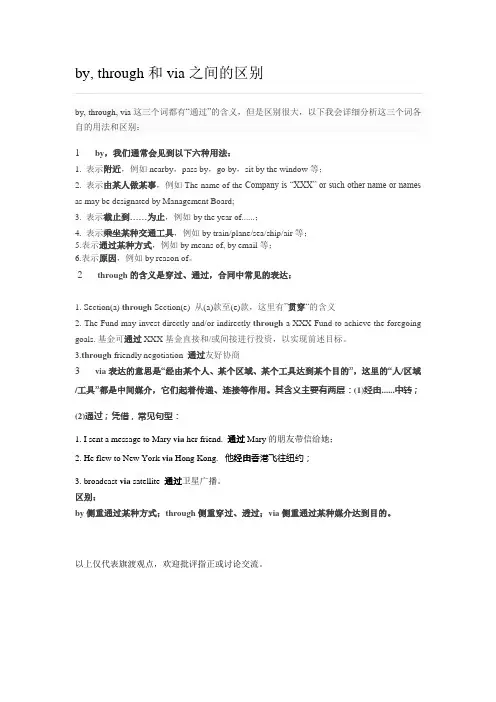
by, through和via之间的区别by, through, via这三个词都有“通过”的含义,但是区别很大,以下我会详细分析这三个词各自的用法和区别:1 by,我们通常会见到以下六种用法:1. 表示附近,例如nearby,pass by,go by,sit by the window等;2. 表示由某人做某事,例如The name of the Company is “XXX” or such other name or names as may be designated by Management Board;3. 表示截止到……为止,例如by the year of......;4. 表示乘坐某种交通工具,例如by train/plane/sea/ship/air等;5.表示通过某种方式,例如by means of, by email等;6.表示原因,例如by reason of。
2 through的含义是穿过、通过,合同中常见的表达:1. Section(a) through Section(e) 从(a)款至(e)款,这里有”贯穿“的含义2. The Fund may invest directly and/or indirectly through a XXX Fund to achieve the foregoing goals. 基金可通过XXX基金直接和/或间接进行投资,以实现前述目标。
3.through friendly negotiation 通过友好协商3 via表达的意思是“经由某个人、某个区域、某个工具达到某个目的”,这里的“人/区域/工具”都是中间媒介,它们起着传递、连接等作用。
其含义主要有两层:(1)经由......中转;(2)通过;凭借,常见句型:1. I sent a message to Mary via her friend. 通过Mary的朋友带信给她;2. He flew to New York via Hong Kong. 他经由香港飞往纽约;3. broadcast via satellite 通过卫星广播。

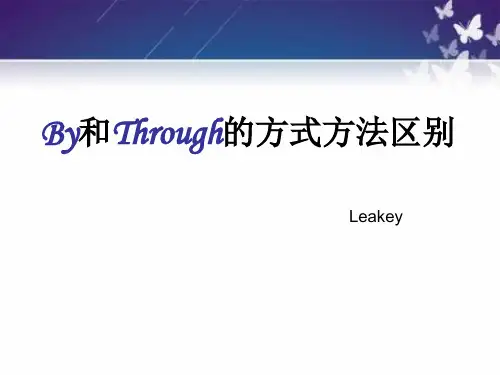
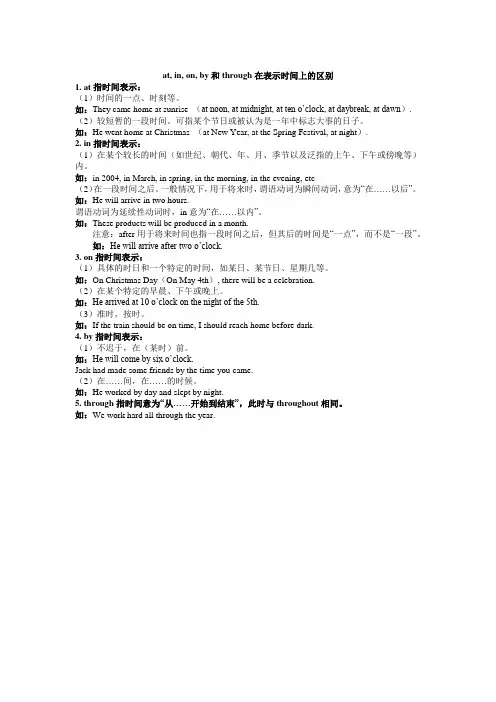
at, in, on, by和through在表示时间上的区别1. at指时间表示:(1)时间的一点、时刻等。
如:They came home at sunrise (at noon, at midnight, at ten o’clock, at daybreak, at dawn). (2)较短暂的一段时间。
可指某个节日或被认为是一年中标志大事的日子。
如:He went home at Christmas (at New Year, at the Spring Festival, at night).2. in指时间表示:(1)在某个较长的时间(如世纪、朝代、年、月、季节以及泛指的上午、下午或傍晚等)内。
如:in 2004, in March, in spring, in the morning, in the evening, etc(2)在一段时间之后。
一般情况下,用于将来时,谓语动词为瞬间动词,意为“在……以后”。
如:He will arrive in two hours.谓语动词为延续性动词时,in意为“在……以内”。
如:These products will be produced in a month.注意:after用于将来时间也指一段时间之后,但其后的时间是“一点”,而不是“一段”。
如:He will arrive after two o’clock.3. on指时间表示:(1)具体的时日和一个特定的时间,如某日、某节日、星期几等。
如:On Christmas Day(On May 4th), there will be a celebration.(2)在某个特定的早晨、下午或晚上。
如:He arrived at 10 o’clock on the night of the 5th.(3)准时,按时。
如:If the train should be on time, I should reach home before dark.4. by指时间表示:(1)不迟于,在(某时)前。
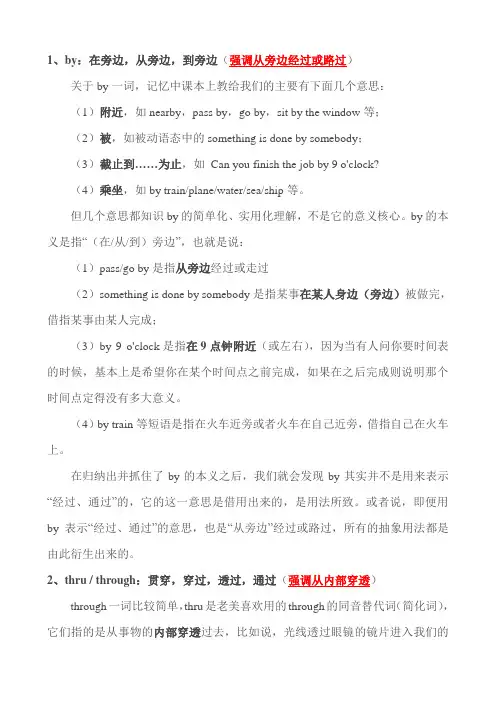
1、by:在旁边,从旁边,到旁边(强调从旁边经过或路过)关于by一词,记忆中课本上教给我们的主要有下面几个意思:(1)附近,如nearby,pass by,go by,sit by the window等;(2)被,如被动语态中的something is done by somebody;(3)截止到……为止,如Can you finish the job by 9 o'clock?(4)乘坐,如by train/plane/water/sea/ship等。
但几个意思都知识by的简单化、实用化理解,不是它的意义核心。
by的本义是指“(在/从/到)旁边”,也就是说:(1)pass/go by是指从旁边经过或走过(2)something is done by somebody是指某事在某人身边(旁边)被做完,借指某事由某人完成;(3)by 9 o'clock是指在9点钟附近(或左右),因为当有人问你要时间表的时候,基本上是希望你在某个时间点之前完成,如果在之后完成则说明那个时间点定得没有多大意义。
(4)by train等短语是指在火车近旁或者火车在自己近旁,借指自己在火车上。
在归纳出并抓住了by的本义之后,我们就会发现by其实并不是用来表示“经过、通过”的,它的这一意思是借用出来的,是用法所致。
或者说,即便用by表示“经过、通过”的意思,也是“从旁边”经过或路过,所有的抽象用法都是由此衍生出来的。
2、thru / through:贯穿,穿过,透过,通过(强调从内部穿透)through一词比较简单,thru是老美喜欢用的through的同音替代词(简化词),它们指的是从事物的内部穿透过去,比如说,光线透过眼镜的镜片进入我们的视网膜,河流穿过峡谷或城镇,某人闯过某片树林或丛林等等。
注意:这个内部可以是完全封闭的(比如身体),也可以是部分封闭的(比如地表或峡谷),甚至可以是开放的(比如某一扇墙壁或门板)。
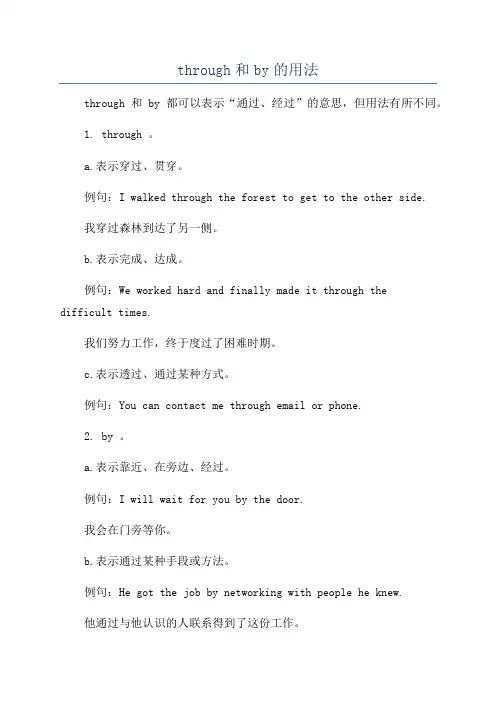
through和by的用法
through和by都可以表示“通过、经过”的意思,但用法有所不同。
1. through 。
a.表示穿过、贯穿。
例句:I walked through the forest to get to the other side.
我穿过森林到达了另一侧。
b.表示完成、达成。
例句:We worked hard and finally made it through the
difficult times.
我们努力工作,终于度过了困难时期。
c.表示透过、通过某种方式。
例句:You can contact me through email or phone.
2. by 。
a.表示靠近、在旁边、经过。
例句:I will wait for you by the door.
我会在门旁等你。
b.表示通过某种手段或方法。
例句:He got the job by networking with people he knew.
他通过与他认识的人联系得到了这份工作。
c.表示依照、按照。
报告是按照公司的指南编写的。
方式介词的用法归纳总结一、概述:方式介词是英语中常见的一类介词,用来描述行为或动作的方式、方法、手段等。
在句子中起到连接名词短语和动词短语的作用,帮助表达出相应的行为或动作方式。
本文将对常见的方式介词进行归纳总结,以便读者更好地理解和运用。
二、表示行为方式的介词:1. By: 以…方式/方法例句:I traveled to Paris by train.(我乘火车去了巴黎。
)In this sentence, "by" introduces the method or means of transportation, which isthe train.2. With: 用…手段/方法例句:She finished the project with determination.(她凭着毅力完成了这个项目。
)Here, "with" expresses the manner or method – determination – with which she completed the project.3. Through: 通过…途径/手段例句:He achieved his goals through hard work and perseverance.(他通过努力工作和毅力实现了自己的目标。
)"Through" indicates the means or way – hard work and perseverance – by which he achieved his goals.三、表示行为对象的介词:1. With: 和…在一起例句:She went to the party with her sister.(她和她妹妹一起去了派对。
)In this sentence, "with" shows the companion – her sister – who went to the party together.2. Using: 使用…工具/方法例句:He painted the wall using a brush.(他使用刷子给墙壁涂上颜料。
through和by的用法"Through" 和 "by" 都是常见的词汇,可以在不同语境中使用。
它们可以表示多种意思且有多种用法。
以下是关于这两个词的详细解释和用法:1. Through:- 作为介词,"through" 可以表示 "穿过"、"通过" 或 "经由"。
例如:- We walked through the park to get to the museum.(我们穿过公园去博物馆。
)- I found my keys after searching through my bag.(在翻遍我的包包后,我找到了我的钥匙。
)- We traveled to Paris by flying through London.(我们经由伦敦乘飞机去了巴黎。
)- 作为副词,"through" 可以表示 "完全地"、"彻底地" 或 "通篇地"。
例如:- I read through the entire book in one night.(我在一晚上读完了整本书。
)- She worked through the night to finish the project.(她工作了一个晚上才完成了这个项目。
)- We listened to the lecture very attentively and took notes through.(我们仔细聆听讲座并做了笔记。
)- 作为形容词,"through" 可以表示 "穿过的" 或 "完全的"。
例如:- The car crashed into the through traffic.(汽车撞到了穿过交通的车辆。
英语重点语法解析by the Internet(一)through和by表示“通过...方式”的用法through表示“通过”,大家都比较熟悉。
比如go through the park (穿过/通过公园),push through the crowds(通过人群),在这里表示“通过”,则是真的是从地理方位上横穿过去。
今天我们要讲的内容是“通过某方式”,使用的是“通过”的转义,通过某人或某媒介,通过某种行为的意思。
【提问】You can get a lot of information (through/by) the Internet. 你可以通过网络获取信息。
在这个句子中,使用through好还是by好,还是两者都可以?(1)through表示“通过……方式”的用法through表示“通过某人、某方式”时,以表示行为方式状语,through 后一般直接跟“人”,“物”,“方式”等名词或短语。
比如:get the book through the library. 通过图书馆借到书。
learn English through practice. 通过实践学习英语。
look through a telescope. 用望远镜看。
make great achievements through one's hard work. 通过努力工作取得很大成就。
(2)by表示“通过……方式”的用法by一般在使用时,表示着“通过某手段或方法”的意思。
[例句]I can keep in touch with friends and family by using WeChat.通过使用微信我能与朋友和家人保持联系。
[例句]By reading, we can broaden our horizon.通过阅读,我们可以扩大视野。
[注]horizon 读音hə'raɪz(ə) n. [天] 地平线;视野;眼界;范围通过这两个例子可以看出,by表示通过某方式时,一般是使用by doing 的形式,begin by doing something 通过做某事开始。
through 和by 的用法
通过和凭借都可以表示“通过某种方式实现某事”,但它们的用法和意义略有不同。
1.通过
“通过”表示通过某种方法、手段或途径达到某个目的或结果。
例如:
I learned English through watching Hollywood movies.(我通过看好莱坞电影学英语。
)
He got the job through connections.(他通过人脉关系得到了这份工作。
)
2.凭借
“凭借”表示依靠某种特定的能力、优势或资源达到某个目的或结果。
例如:
She succeeded in business by her intelligence.(她凭借聪明才智在商业上取得了成功。
)
He won the game by his excellent physical strength.(他凭借出色的体力赢得了比赛。
)
总的来说,通过强调的是方法、手段或途径,而凭借强调的是能力、优势或资源。
两者的区别在于强调的点不同。
在日常生活中,我们可以根据具体语境选择使用适当的词语。
by和through的区别和用法
“by”和“through”在英语中具有不同的含义和用法。
1、含义上:
“by”通常表示经过某物或某地,或者通过某种方式或手段来达到某个目的。
它也可以表示时间上的经过,如“by the end of the day”(在一天结束之前)。
“through”则更侧重于从一端到另一端的动作,通常表示物体或人的移动穿越某个空间或物体。
它也可以表示完成某个过程或经历某种情况,如“go through the door”(穿过门)或“go through
a difficult time”(经历一段困难时期)。
2、用法上:
“by”后面通常跟名词或动名词,表示通过某种方式或手段,如“I learned it by reading the book.”(我是通过读这本书学到的。
)
“through”后面则通常跟名词或代词,表示穿越某个空间或物体,如“She walked through the crowd.”(她穿过人群。
)总的来说,“by”和“through”在含义和用法上有所不同,需要根据具体的语境来选择使用哪个词。
By和Through的方式方法区别
一、by的用法
(1)表示方法,手段。
即“用……;通过……”相当于by means of。
e.g. ①All work had to be done by hand. 所有的工作都是手工进行的。
e.g. ②He makes a living by teaching. 他以教书为生。
(2)表示传达、传递的方式或煤介。
e.g. How did you send the letter, by airmail or by ordinary mail? 你是怎么发送的这信,是通过航天邮件还是普通邮件?
(3)表示用交通工具、通讯工具后接名词单数,不加冠词。
e.g. He came by train, but his wife came by bus. 他是乘火车来的,可是他老婆是坐公共汽车来的。
(4)指数量增加或减少了的程度,相差。
e.g. ①We lost the match by one goal. 我们仅以一球之差输了比赛。
e.g. ②The output of steel went up by 20 percent.钢产量增长了20%。
(5)根据,按照,以……计
固定搭配:
pay sb by the hour /day/week
sell sth by the pound /meter/ dozen
sell sth by weight/length
e.g. As a rule,domestic servants doing odd jobs are paid by the hour. 通常,家政服务是按照小时计酬的。
(do odd jobs做零工;打零工)
二、through的用法
(1)表示“以;通过;经由”。
e.g. He succeeded through hard work. 他通过努力获得成功。
(2)空间上通过,透过,经过
e.g. Light comes in through the window。
光线从窗户进来。
(3)时间上通过,自始至终,从头到尾经过
e.g. He often works through the night. 他常常通宵工作。
注:在表示手段表示“藉着;以……;经由”时,by,through有时也可换用。
e.g. Through his efforts he succeeded in making so many useful inventions.
By his efforts he succeeded in making so many useful inventions
He became rich through hard work.他靠努力工作而致富。
三、by和through的固定搭配
(1)by
by and by不久以后;不一会儿
by and large 全盘;总的来说
in days gone by 昔日
put your work by for a minute 把你的工作稍搁片刻
These oranges were put by for the winter.
这些桔子被储存起来留冬天吃。
(2)through
①through:透;彻底
be wet through浑身湿透
②through:自始至终,从头到尾
Have you read the letter through?你看完信了吗?
③through:情况好;取得成功
I got through with good marks.我考的成绩很好。
④through:打通,接通(电话)
Can you put me through to Mr Jones?请帮我接通琼斯先生电话。
⑤through:做完的;完成的;完毕的
I'm not through just yet.我还没做完。
⑥through:从头到尾
travel through the country游遍全国
go through a bottle of wine喝完一瓶酒
through the ages 古往今来
You are through. [英]你要的电话接通了
Are you through?[美]你的电话打完了吗?
四、by和through的区别
(一)By和Through的区别一
1、by 是通过某种方法by something
①表示以一般的方法或方式。
e.g. No one in those days could live by writing poems.
②表示传达、传递的方式或煤介。
e.g. How did you send the letter, by airmail or by ordinary mail?
2、through 是通过某种途径through some methods
①He bought the antique vase through a dealer.他通过一个商人买到这只古花瓶
②He became rich through hard work.他靠努力工作而致富。
(二)by和through的区别二
1、by表“用交通工具”或表“发出某动作”
I go to school by bus.
2、through通过具体过程,途径,手段,中介
I learned it through a friend.
(三)by和through的区别三
1、by指时间表示:
(1)不迟于,在(某时)前。
e.g. He will come by six o‟clock.
Jack had made some friends by the time you came.
(2)在……间,在……的时候。
e.g. He worked by day and slept by night.
2、through指时间意为“从……开始到结束”,此时与throughout相同。
e.g. We work hard all through the year.
(四)by和through的区别四
①by后可跟doing sth.。
另外,by还可表示“经由”。
e.g. We went to Beijing by Tianjin.我们经天津到北京。
What do you mean by that ?你那是什么意思?
You can…t be helped by telling lies.你靠撒谎是得不到帮助的。
②through后面只能跟名词或代词。
We got the news through our friend.我们通过朋友知道了这个消息。
Look through the window and you can see what is happening in the street.通过窗户你可以看到街上所发生的事。